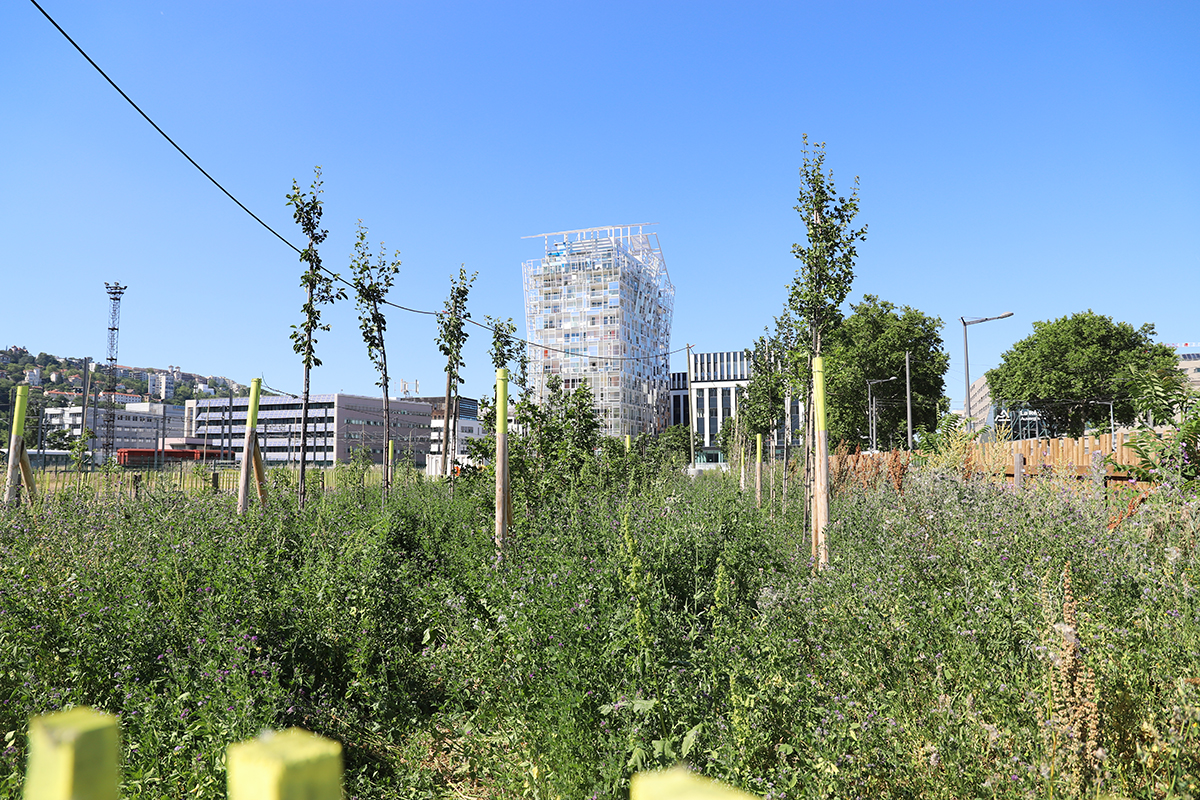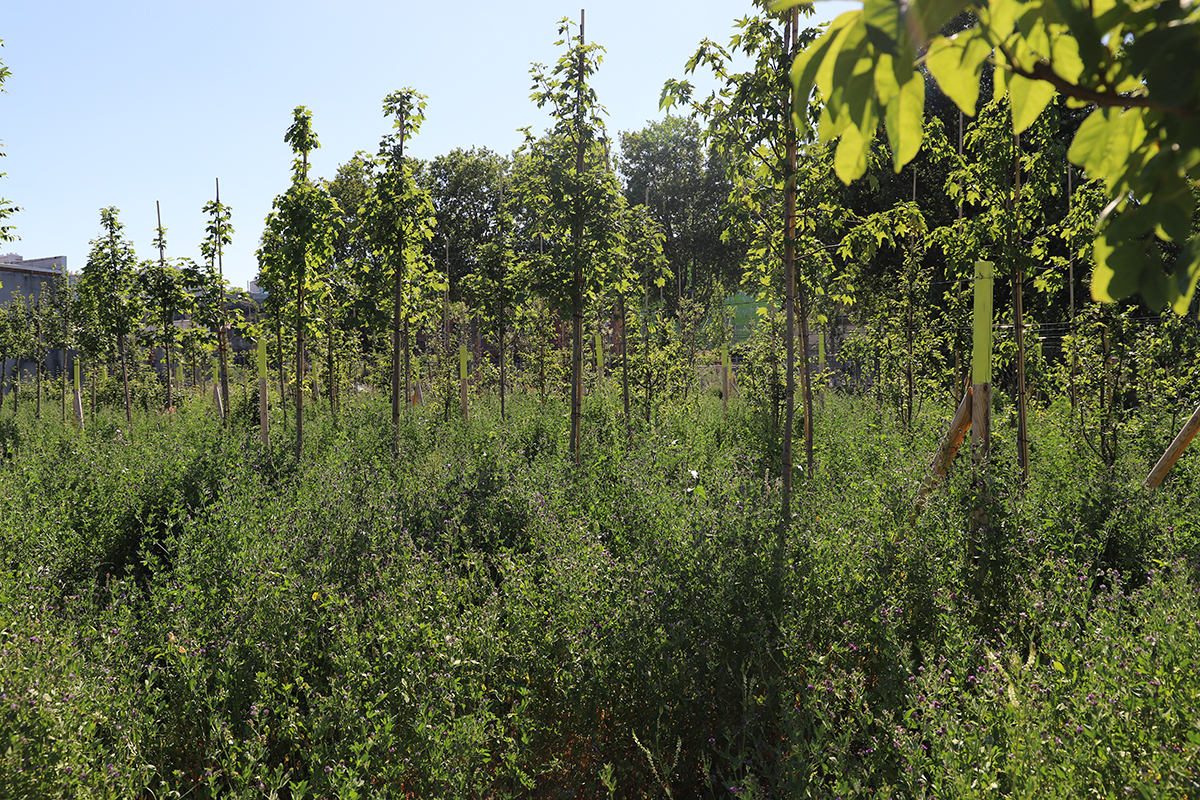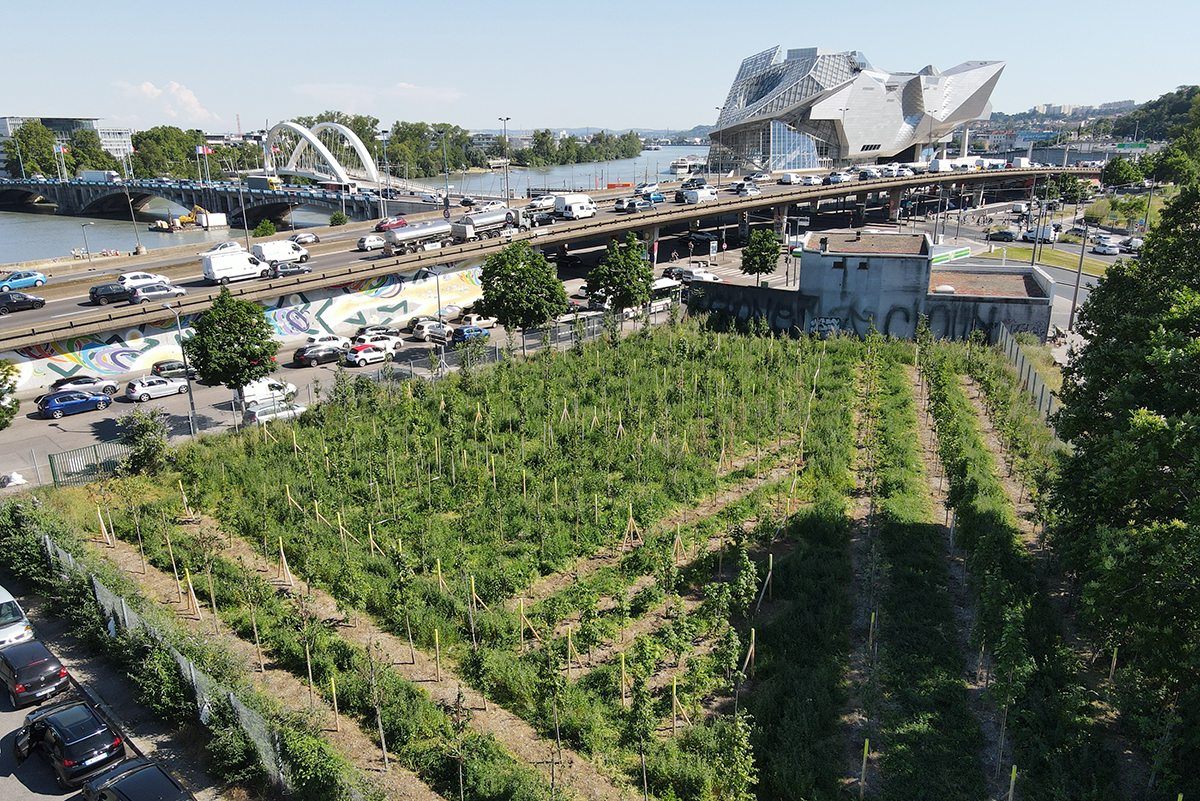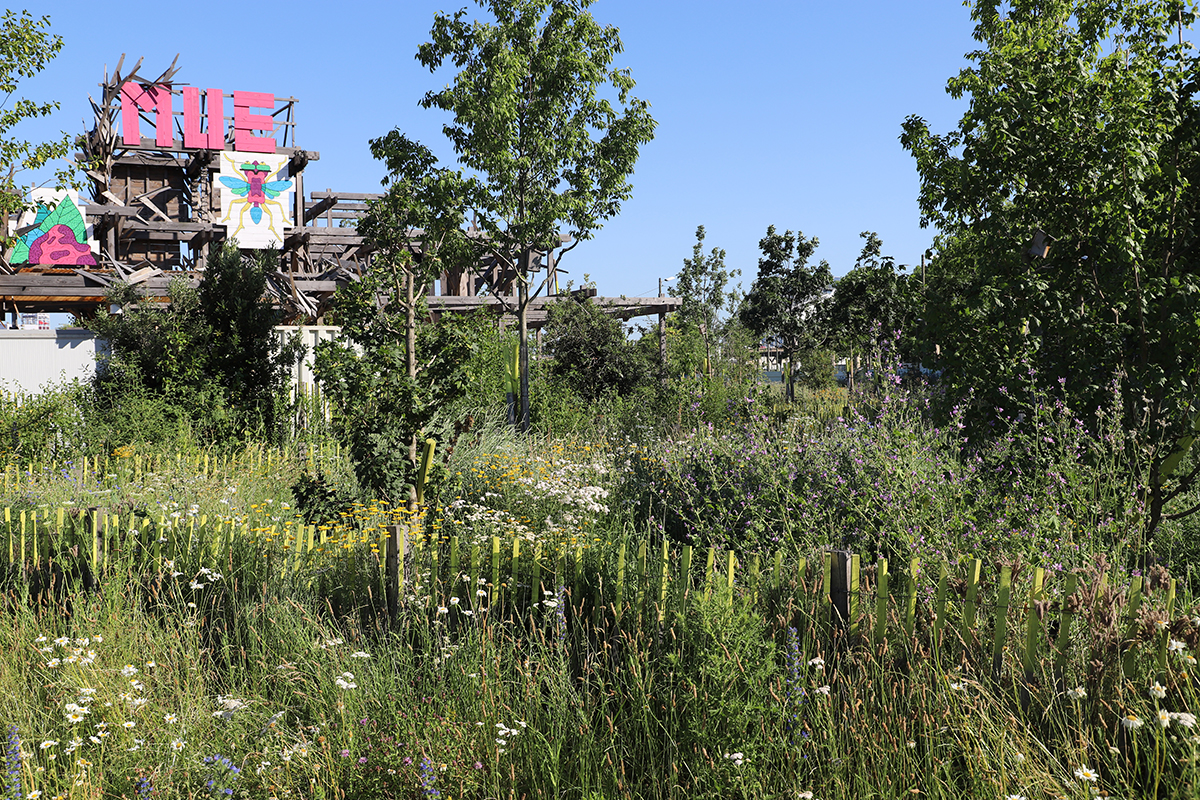When work started to further develop Michel Desvigne’s vision, SPL Confluence challenged candidates tendering for the work to put forward ideas around two key questions:
- How to manage the transition from a 5.5-hectare bare brownfield to a highly vegetated landscape, knowing that all plots of land will not become available at the same time?
- How to radically change the image of the site early on, enabling resident to take ownership of the new neighbourhood while it is still largely under development?
“One of the ideas we brought to the project was to start planting well-ahead of the development to take advantage of the space it provides for experimentations, and of the time available to create a more mature landscape for the future neighbourhood,” explains Bertrand Vignal, co-founder of Agence Base who was awarded the work.
“We’ve also aimed at creating a project that consumed as little resources as possible, giving landscape establishment priority over buildings. It is widely acknowledged today that creating high quality, resilient new neighbourhoods requires starting with the landscape and respecting the local soil resource. But these principles are seldom translated in operational terms and fully adhered to when time comes for detail design and implementation.
“The scope of the brief we were tasked with was instrumental in giving us the level of control needed to really implement these practices: we were awarded responsibility for finalising the overall masterplan, the design codes that will shape the development of individual private plots and the detailed design of all the public realm. What’s also been decisive is that, within the wider Confluence peninsula, some denser developments were already underway in earlier phases of the project, so we had the ability to plan a more open urban fabric, providing ample scope for extensive planting.”
As initial preliminary studies took place, soil fertility quickly appeared to be a key challenge – if not the key challenge for the project. Le Champ is entirely set on highly compacted and inert rubble.
“In response to this unpalatable discovery, we decided to rise soil levels rather than excavating – so as not to burden any other site with waste. This also gave us one of the major themes to be explored as part of the experimentations we wanted to conduct: how can we nurture nature back into the city? How do we reinstate fertility?”
The need for a place where possible answers to these questions could be tested, discussed, or showcased led to the creation of a temporary venue called the Moult Station. Set on plots scheduled to be developed in the later phases of the project, the Moult Station includes a dismountable wooden pavilion surrounded by 5,000 square meters of land used to trial approaches to greening.
“The site for the Moult Station was particularly arid – so we used insect to help burry seeds into the ground. The term ‘moult’ referred to the moult of insects and other animals, but also to the broader transformation of the site. The Moult Station provides a space to publicise, explain and facilitate citizen participation in the project. Schools, charities, and community groups can book the space for their own events. It is also used as a venue for the cultural programming that defines the Lyon scene – e.g. Light Festival, contemporary dance, etc. The Moult Station has been one of the means to very quickly transform the site and its relationship the surrounding city life”.
The spaces identified for early greening around the Moult Station were covered with pure loams and a mix of loams and compost to reproduce the horizon structure that naturally occurs in healthy soils and help enhance water retention.
“We tried planting into this substrate very rapidly,” recounts Bertrand Vignal, “and learned the hard way how difficult it is to establish trees and an herbaceous layer in freshly created “technosoils”, i.e.: human-made soils. The vegetation really struggled to establish over two years.
“We concluded from this that we needed a more fertile, and therefore more mature growing media. Since we had a significant amount of space available onsite: we thought we would create a “Fabrique à Terre” – i.e. an onsite “soil factory”.
“We sited this project on the plot scheduled to be developed last. There, we created a series of swathes or long ridges, allowing to test different soil-making techniques. Some of these swathes were inoculated with topsoil. In a typical scenario, most of the materials we used would, for the most part, have ended up in a landfill. We mixed to some of the local soils some loams recycled from a local major infrastructure project and compost produced from local green waste.”
To succeed in sourcing all materials locally, SPL Lyon Confluence and its design team were able to capitalise on the experience the Greater Lyon Authority has acquired over the past 25 years in promoting circular economy principles to address local soil pollution issues and meet the increasing demand for fertile growing media generated by its own urban greening policies. The Greater Lyon Authority has established a “metropolitan soils exchange” to facilitate recycling of soils and excavation materials within the conurbation for both public and private projects. This is backed by local planning policy, requiring large developments to map soil resources at planning application stage, and provide a clear plan for the sustainable management of all soil resources and excavation materials. The Greater Lyon Authority has also sponsored a research programme nicknamed “Terre Fertiles 2.0” (i.e. Fertile Soils 2.0) as well as the development of an incubator for start-ups focused on developing processes to produce fertile growing media from waste, and decontaminate soils through vegetation management.
The growing media created in Le Champ’s “soil factory” is laid in different horizons in “mega planting trenches” designed to provide optimal growing conditions for the 1,000 large-growing trees to be planted onsite. The goal is to emulate the growing environments found in natural woodlands, with few obstacles to the development of large tree root systems, mycorrhiza, and widespread resource sharing.
The bottom of the planting trenches is laid with loams. An intermediary horizon made of loams and limited amounts of compost sits above. The top horizon is compost-rich, and free draining. Installing such growing media requires a different approach to landscape works management: contractors have to work through each areas several times, so as to lay one horizon at a time.
The location of the mega planting trenches is optimised to avoid waste. Paths will be created with no dig solutions or limited foundations on top of these large planting areas, and buildings will be set around them.
The creation of mega-planting trenches underpins a proactive planting strategy, combining long-term and temporary plantings. “Once a plot of land become available, our approach is to green it as quickly as possible so to avoid losing the land to other uses such as temporary parking or storage of materials,” explains Marie-Paule Coassy, Project Manager at SPL Lyon Confluence. “The project area includes three existing buildings that will be retained and a range of new buildings that will be set within a newly created and yet already established landscape. Our planting strategy involves:
- Long-term planting in the locations where we are relatively sure of the future layout, such as around the retained buildings, with the idea that on-going management will allow to optimise things as time goes on.
- Temporary planting where we are less sure of where the main buildings will be – with the objective to ensure the result is not simply cosmetic, but also immediately useful. This is how the idea of having some onsite tree nurseries became relevant.”
Le Champ not only produces its own soil, it also grows its own trees in three onsite nurseries. There were multiple reasons for this audacious choice:
- It supports Agence Base’s strategy to make the most of the long development timescales that characterises the project. The tree nurseries bring to life plots that would otherwise lay vacant and result in an immediate and drastic change of image. “There was nothing there before and within two days, boom, there were trees everywhere,” recalls Bertrand Vignal.
- The young trees grown onsite are expected to be better equipped to deal with the harsh local climate and recover much better from their transplantation into their final location. “Lyon is acutely impacted by the impacts of climate change and rapidly becoming much more prone to drought than before. This is making tree establishment increasingly difficult,” explains Vignal.
- Crucially, onsite tree production also proved instrumental to ensure the project would remain true to the vision of a contemporary district woven into a naturalistic wooded landscape. “Relying on trees that belong more to a neat avenue than to a forest setting would have compromised the project,” explains Marie-Paule Coassy. “Our ambition to artificially create a ‘forest setting’ raised questions not only about tree species selection but also about tree form and tree size. To give a sense of maturity without waiting a couple decades, we needed to source a mix of tree sizes. Commercial nurseries produce ‘trained’ forms that are suitable for roadside plantings or other amenity projects and rarely offer trees with “free form”. The mix of tree species, tree forms and tree sizes we wanted for the project simply wasn’t available on the market.”
- Onsite tree production also helped the project fulfil some of its biodiversity ambitions. “We were able to put in the project brief that the seed source for the trees had to be both diverse and of regional provenance via the French certification scheme called Local Plant,” further explains Coassy.
The trees grown for future transplanting within Le champs are spread across three nursery sites, each hosting a different size profile: forest saplings, standards or select standards (ie 8-10cm or 10-12cm in girth at time of planting in the nursery) and heavy standards or extra heavy standards (12-14cm or 14-16cm at time of planting in the nursery).
Managing the delivery of this project took Terideal, the landscape contractor awarded the contract to set-up and manage the three sites, on an extensive learning journey.
“The contract we entered into didn’t require us to arrange for any kind of training per se, however, it was very clear to us that landscape works and plant production are two very distinct professions. Our staff needed to acquire additional skills,” explains Mathieu Desbat.
“So, we worked closely with our two suppliers, Cholat and Daniel Soupe nurseries. Ahead of the planting we sought their advice on technical matters such as the spacing to provide between rows and individual trees, the diameter and height of the stakes to use for the different types of plants we were going to grow, the tension of cables used as supports, etc.
“Once we reached the planting stage, staff from Cholat delivered onsite training on formative pruning. They showed us the pruning techniques to apply to each of the 20 or so species we were working with prior to planting.
“This project has challenged our habits and traditional practices. Take landscaping works associated with tramway projects for example: planting specification for such projects invariably call for many thoroughly identical trees, with a single high clear stem. To meet such brief, we often need rely on foreign nurseries based in Germany or Belgium that produce the required species in large enough quantities. The three tree nursery sites we manage within Le Champ seek to achieve a diametrically opposed outcomes: we are expected to produce trees that have been left to develop naturally according to their own genetic potential, with short stems and multiple boughs close to the ground… We had a really hard time sourcing suitable plants for this. This is the reason why although we are only producing about 300 trees, we had to rely on two different suppliers.”
The creation of the three tree nurseries was managed through a landscape works contract addressing the supply and set up of a suitable growing environment, the sourcing and planting of the young trees and post-planting care for four years running until 2024.
The tender had to be issued to landscape contractors rather than to tree nurseries “because nurseries could not take responsibility for the works associated with setting up the sites, whereas a landscape contractor could,” explains Coassy.
The future handover of the trees grown in Le Champ’s nurseries will pose several challenges that are yet to be addressed. “Once construction works start on the public realm, it is entirely possible that the landscape contractor appointed, who will be asked to source its trees from our onsite nurseries, will not be Terideal. This contractor will be using trees which will not be subject to the same warranty as commercial nursery provide,” explains Marie-Paule Coassy. “This is both unusual and tricky she adds, as these future landscape contractors will also be asked to take some responsibility for the trees they plant.
“As a mitigation measure, a lot more trees than what was needed was planted – so that we could have “spares”. This “over-planting” is also a response to the lack of definition we have regarding the exact number of trees each individual plot will need. Across the sites we could dedicate to tree growing, we simply maximised planting within the available space.”
SPL Lyon Confluence has two other small onsite tree nursery sites, intended to produce trees for streets and a square sitting outside Le Champ’s project boundary, which are also grappling with comparable uncertainty and potential contractual complexity. There is more learning to come on this aspect of the project.



















